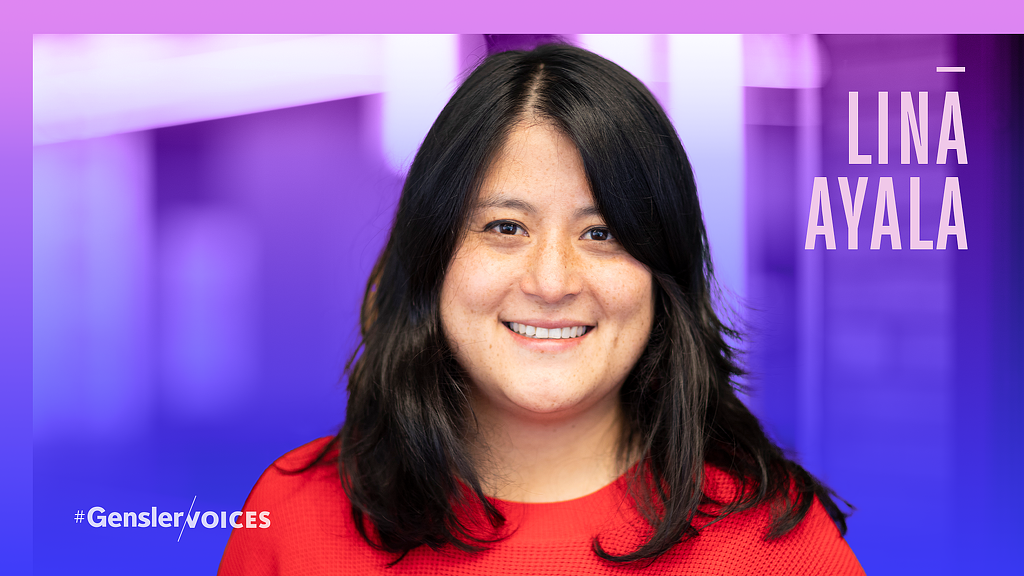Gensler Voices: Lina Ayala on the Power of Mentorship in Her Career
This Q&A is part of a series of interviews with Gensler architects, designers, and others in the firm about their career journey, and the impact that design and architecture can have on our communities and the human experience. Here, we sit down with Lina Alaya, a residential practice area office leader in our Sydney office:
How were you first introduced to architecture and design?
My earliest memories were of the time spent in my father’s studio where he spent what seemed endless hours painting. I would keep myself entertained watching him paint, playing with his paintbrushes, inspecting his intricate wooden architecture models, and flipping through the images of National Geographic magazines. He really tried to enrich my life at a young age with art and you could say that from a young age I enjoyed and understood the world through a visual and graphical lens. By the time I was four years old, he had set up a little drawing table next to him for me. I think that set the course to the rest of my life. Drawing became a form of distraction, meditation, and relief. I’ve always loved getting lost in it. With a father as an artist and architect, I grew to believe that the approach to architecture and art are one and the same. Architecture is a form of art where we sculpt environments to heighten and elevate our existence.
If you could impart any piece of advice to individuals beginning their design career, what would it be?
Each project, each task, no matter how small, is an opportunity for growth and learning. In time and over the years, you’ll realize that all these efforts all add up to ensure the success a project.
Did you have a mentor growing up or at any point during your career? If so, how did that relationship impact your growth as a person or in the industry at large?
Yes! Barrie Fernandez. We worked together in our London office. All the values and work ethic that I hold on to this day come from her. She taught me to have confidence in myself and this meant a lot me when I was a young woman working in a very male dominated industry. With that mindset, she taught me the importance of not being intimated in asking questions and being honest when I did not know the answer to a question. One of the most valuable wisdoms she taught me was importance “we” and “our” as essential words in my vocabulary to present our work to others.
What do you think are the most important skills to succeed in architecture?
Learning to let go – sometimes we become so married to an idea that it’s hard to let go even though it keeps hitting barriers. There is merit in stepping back, reassessing and pivoting. And use these abandoned ideas or “mistakes” as learning opportunities to enrich the new route.
What is your favorite Gensler project and why?
It’s hard to say which is my favorite but the projects that were the most interesting to me where those that occurred during major historical and economic shifts, like the economic recession of 2008 and the COVID-19 pandemic. In each of these scenarios, the world came to a halt, and it had to reassess its priorities and direction. With that mindset, the construction industry transforms and forces us rethink the way we design offices, residences, retail, cities, etc.
For example, we are now influenced to transform cities and communities so that they respond to emergency preparedness and response when a pandemic comes around. Residential projects have become critical in providing workplace environments and health and wellness facilities for their tenant. The problem solving involved in transformations like this are what I find most engaging.
What’s the best career decision you’ve ever made?
Taking advantage of the international opportunities to practice architecture. I’ve had the chance to work in our D.C., London, New York and now part of our Sydney office and have called these places home. With a global exposure, you have a chance to appreciate all the qualities that make each of these cities, cultures and landscapes unique. At the same, you find commonalities and connections that bind humanity, and you realize how tightly we really are all intertwined socially, politically and economically.
How has your work mindset shifted as you’ve advanced in your career?
Not feeling intimidated by the unknown and unfamiliar but embracing it as opportunities for growth in knowledge.
What are you most excited for when it comes to the future of architecture and design?
During my undergraduate education, passive, sustainable and environmentally conscious strategies were intrinsic principles in architectural design. It was a shock to enter the working world in the early 2000’s, where the adoption of these principles was optional and often not integrated. Now that climate change demands an urgent global response, it is very encouraging to hear that reduction in carbon emissions, alternative energy strategies and passive design are part of our vocabulary when we discuss projects with clients, consultants, and policy makers. It is exciting to collaborate and participate in opportunities where we are problem solving and finding strategies that will help us create cities, buildings and communities that can mitigate and adapt to the pressures of climate change.
For media inquiries, email .
